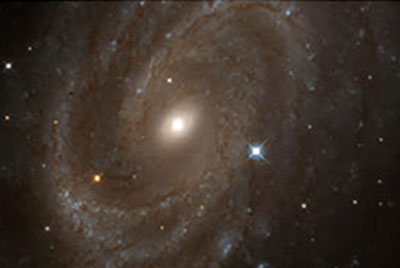A computer simulation depicting a large chunk of our universe
G. L. Bryan, M. L. Norman, UIUC, NCSA, GC3
Related links:
A Matter of Scale - interactive showing the sizes of things, from very tiny to huge - from NSF
The Cosmos
Cosmology is the study of the overall structure of the universe. Just what is the Universe? It is everything that exists. However, from Earth we cannot observe everything in the Universe. Some things are dark (brown dwarf stars, planets, and Dark Matter) and we cannot see them. Additionally, there are parts of the universe whose light has not yet reached us in this part of the Universe. And because light travels at a set speed we actually
look back in time when we look into the cosmos.
Astronomers observe some interesting structure in the Current Universe. That structure can tell us much about the History of the Universe. It can also tell us what we can expect for the Future of the Universe and beyond...
You might also be interested in:

NASA launched its newest satellite on June 24, 1999 from Cape Canaveral.The Far Ultraviolet Spectroscopic Explorer (FUSE) began its mission aboard the new Delta II rocket, which helped get the satellite
...more
After eight long years, the Hubble Space Telescope Key Project Team finally revealed what they believe is the real Hubble Constant. The Hubble Constant is the speed which the Universe is expanding at.
...more
Some ideas are used throughout the sciences. They are "tools" that can help us solve puzzles in different fields of science. These "tools" include units of measurement, mathematical formulas, and graphs.
...more
In the 1960's, the United States launched some satellites to look for very high energy light, called Gamma Rays. Gamma Rays are produced whenever a nuclear bomb explodes. The satellites found many bursts
...more
During the early 1900's, which is not very long ago, astronomers were unaware that there were other galaxies outside our own Milky Way Galaxy. When they saw a small fuzzy patch in the sky through their
...more
Neutron Stars are the end point of a massive star's life. When a really massive star runs out of nuclear fuel in its core the core begins to collapse under gravity. When the core collapses the entire star
...more
Spiral galaxies may remind you of a pinwheel. They are rotating disks of mostly hydrogen gas, dust and stars. Through a telescope or binoculars, the bright nucleus of the galaxy may be visible but the
...more















